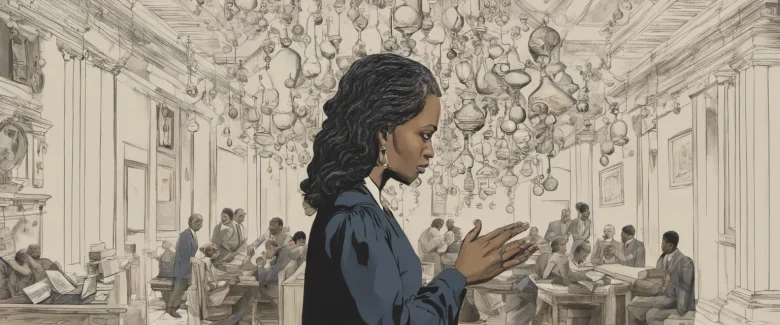In her groundbreaking book “Caste: The Origins of Our Discontents,” Isabel Wilkerson exposes the deeply embedded system of caste in America and its profound impact on society. Drawing parallels with the caste systems of India and Nazi Germany, Wilkerson unveils a thought-provoking exploration of how this hidden framework determines our lives, often unbeknownst to us. As a Pulitzer Prize-winning author, Wilkerson has distinguished herself as a leading voice on issues of race and inequality in America. With meticulous research and compelling storytelling, she exposes the intricacies of caste and invites readers to reconsider fundamental assumptions about the world we inhabit.
Chapter 1: Introduction to Caste
Isabel Wilkerson‘s book “Caste” serves as an opening salvo in exploring the deeply entrenched caste system ingrained in societies across the globe, with a particular focus on the United States. Wilkerson introduces the concept of caste, identifying it as a hidden social hierarchy that determines an individual’s place, opportunities, and treatment within society.
Drawing parallels with India’s caste system and Nazi Germany’s treatment of Jews, Wilkerson dispels the notion that the United States is immune to such a rigid social structure. She argues that caste is a powerful, yet mostly unacknowledged force that shapes people’s lives, affecting their chances of success or failure, education, and access to resources.
Wilkerson highlights the unseen barriers and biases that perpetuate caste systems, subjugating marginalized groups and maintaining the supremacy of those in dominant positions. She asserts that caste is not solely defined by race or socioeconomic status but incorporates an intricate web of power dynamics, relegating certain groups to lower positions to maintain the social order.
The author provides examples of caste dynamics in various societies, including the Jim Crow era in the United States, where Black people were subjected to violence, segregation, and denied equality. She describes caste as a rigid, unyielding structure that influences all aspects of life, consciously or unconsciously, leading to dehumanization, discrimination, and unequal treatment.
Wilkerson concludes the chapter by asserting that by recognizing and understanding the pervasive influence of caste, societies can begin to dismantle its harmful effects and work towards achieving true equality and justice. She urges readers to challenge preconceived notions about social hierarchy and confront the uncomfortable truths embedded in their own societies.
Chapter 2: Birth of a Hierarchy: The Origination of Caste in America
The Origination of Caste in America,” delves into the historical development of caste in the United States. The chapter explores the origins of America’s racial hierarchy and examines how the notion of caste played a crucial role in shaping the social structure of the country.
Wilkerson begins by highlighting the early Dutch settlement of New Amsterdam, which later became New York City. She explains how the Dutch introduced the concept of segregation by bestowing different legal rights and privileges upon European settlers and enslaved Africans. This system laid the foundation for the creation of America’s caste system, separating people into dominant and subordinate groups based on the color of their skin.
The chapter further explores the intertwining of caste and racism during the colonial era. Wilkerson illustrates how the ruling class implemented laws and practices to solidify their superiority over enslaved Africans and Native Americans. She describes the evolution of race-based slavery, as well as the influence of the eugenics movement, which sought to scientifically justify the supposed inferiority of marginalized groups.
Wilkerson emphasizes how the American caste system structured all social, economic, and political aspects of life, even long after the abolition of slavery. She cites various social stratification mechanisms, such as the Great Migration and the Jim Crow era, that perpetuated racial segregation and subordination.
Ultimately, Chapter 2 underscores how caste became deeply ingrained in America’s social fabric, persisting to this day. By examining historical patterns and practices, Wilkerson highlights the profound impact of caste on American society, providing a foundation for the subsequent exploration of caste systems in other countries.
Chapter 3: Anatomy of Caste: The Eight Pillars
The Eight Pillars.” In this chapter, Wilkerson delves deeper into the structure and mechanisms of caste systems, drawing comparisons between the caste systems in America (racial hierarchy) and India (traditional caste system) to highlight the commonality in their underlying principles.
Wilkerson begins by explaining the eight pillars of caste, which are outlined as divine will and the laws of nature, heritability, endogamy and the control of marriage and mating, purity versus pollution, occupational hierarchy, terror as enforcement, hereditary and inflexible status, and caste consciousness. Each of these pillars is explored in detail to demonstrate their role in upholding and perpetuating caste systems.
She argues that caste systems, regardless of the specific society they operate in, rely on a belief in the inherent superiority or inferiority of people based on their birth, rather than their individual qualities or achievements. Caste systems enforce strict social and economic hierarchies, where movement across caste lines is severely limited.
Wilkerson highlights the role of caste consciousness, which is the internalization of the caste hierarchy by individuals belonging to different castes. This consciousness becomes deeply ingrained in people’s minds, perpetuating the divisions and ensuring the stability of the overarching system. She also explores how terror is a tool used by dominant castes to maintain control and suppress any potential challenges to the existing caste order.
Ultimately, through the exploration of these eight pillars, Wilkerson exposes the insidious and pervasive nature of the caste system. By making these comparisons, she intends to deepen the readers’ understanding of caste as a powerful and relentless force that shapes societies, and prompts them to critically examine its effects in their own lives and within their societies.

Chapter 4: The Heart Stopped Beating, but the Body Lived: Enduring Symbols of Caste
Enduring Symbols of Caste” in Isabel Wilkerson’s book “Caste” focuses on the ways in which caste manifests itself through symbols and rituals, both overt and subliminal, in different societies around the world.
The chapter begins by examining the Indian caste system, where caste symbols are deeply ingrained in society. Wilkerson discusses the origins of the caste system, the strict hierarchy it enforces, and how symbolic markers such as last names, clothing, and signage perpetuate this system. For example, in India, one’s surname can reveal their caste, and low-caste individuals may be prohibited from wearing certain clothing or accessing certain spaces.
Wilkerson then shifts her focus to the United States, exploring how caste is silently reinforced through symbols and rituals. She analyzes the role of “whiteness” as a symbolic marker of superiority and examines how it has been used to justify slavery and segregation. Wilkerson delves into the haunting symbolism of lynching, highlighting how it was both a form of racial terror and a public display of caste hierarchy, reminding Black Americans of their place at the bottom.
Furthermore, the chapter examines symbolic rituals that perpetuate caste divisions, such as table manners and dining etiquette. Wilkerson explains how these seemingly innocuous actions reinforce caste distinctions by dictating who is allowed to eat with whom and in what manner. Through these social cues, dominant castes maintain their power and superiority, often without explicit confrontations.
Overall, Chapter 4 uncovers the pervasive and enduring symbols of caste, both in Indian society and within the American context. By analyzing the significance and implications of these symbols and rituals, Wilkerson highlights how caste continues to shape and restrict societies worldwide, perpetuating inequality and maintaining divisions between different social groups.
Chapter 5: Terrorizing the Dominant Caste: The Enforcement of Caste in America
Chapter 5 of “Caste” by Isabel Wilkerson explores the various ways through which the enforcement of caste has been perpetuated in America. The chapter is titled “Terrorizing the Dominant Caste: The Enforcement of Caste in America.”
Wilkerson begins by delving into the various tactics employed to maintain the hierarchical social structure in the United States. She highlights the role of violence, terrorism, and public humiliation as tools used to instill fear and maintain the superiority of the dominant caste over marginalized groups, particularly African Americans. Lynchings, race riots, and the Ku Klux Klan are discussed in detail, illustrating how these acts of violence were used to assert caste dominance and enforce social control.
The author also examines the development of racial segregation and the legal framework that upheld and normalized discrimination, such as Jim Crow laws and practices. She points out how these restrictive laws not only marginalized African Americans but also threatened their lives, livelihoods, and basic human dignity. The enforcement of segregation through practices such as redlining, which denied Black people access to housing and economic opportunities, further solidified the hierarchical caste structure.
Wilkerson emphasizes the psychological impact of the enforcement of caste, as it created an atmosphere of terror and fear in the lives of marginalized individuals. She explains that this psychological violence was aimed at maintaining the perceived order of caste, effectively dehumanizing and subjugating those who challenged it.
In this chapter, Wilkerson elucidates how violence, intimidation, and humiliation were instrumental in enforcing caste divisions in America. By examining historical events and legal frameworks, she highlights the significance of these tactics in perpetuating the social hierarchy and the systemic oppression of marginalized groups.
Chapter 6: When ‘White’ Isn’t Enough: The Interchangeability of European Ethnicities
The Interchangeability of European Ethnicities,” explores the complex dynamics of European immigrants’ experiences in America. Wilkerson delves into how ethnic identities such as German, Irish, Italian, and others were reshaped over time to fit within the overarching construct of “whiteness.”
The chapter highlights the early struggles faced by European immigrants as they encountered hostility and discrimination upon arrival in the United States. These newcomers faced derogatory stereotypes and often encountered unsavory living and working conditions. Wilkerson emphasizes that these experiences initially prevented European immigrants from being fully accepted into society as “white” Americans.
However, as time progressed, Wilkerson argues that European immigrants gradually assimilated into the dominant white culture and accepted the privileges associated with it. She examines how they distanced themselves from their ethnic origins to assimilate into a unified “white” identity, enabling them to rise in social status. Adopting Anglicized names, shedding accents, and downplaying cultural practices allowed these individuals to become indistinguishable from the prevailing white majority.
Wilkerson highlights that this process of assimilation and interchangeability came at the cost of preserving a diverse heritage. She argues that the erasure of ethnic individuality ultimately perpetuated the caste system and its hierarchy, as Europeans gained the privileges of whiteness at the expense of other marginalized groups. By investigating the experiences of European immigrants, Wilkerson illuminates the racial dynamics and interconnectedness that shaped America’s caste system.

Chapter 7: The Many-Headed Hydra: The Early Diversity of Caste in America
The Early Diversity of Caste in America,” delves into the early history of caste in America and explores how the rigid social hierarchy began to take shape in the new world.
Wilkerson begins by highlighting the diversity that existed among the early European settlers. She explains that different groups held various positions within the social order, such as the English at the top, followed by other Europeans, and then Africans who were initially seen as indentured servants rather than slaves. She emphasizes the fluid nature of these early caste distinctions, where individuals from various backgrounds had the potential for upward mobility or downward mobility based on factors like their skills and independence.
The author then examines the origins of the term “white” as a way to create a unified and superior identity for Europeans in contrast to Africans and Indigenous individuals. By creating a new racial caste that excluded people of African and Indigenous descent, the foundations for a deeply entrenched hierarchy in America were laid.
Wilkerson continues by discussing how these caste divisions perpetuated and deepened through the institutionalization of laws, practices, and beliefs that perpetuated white supremacy and served to maintain the power of those at the top of the hierarchy. She explains how the early settler colonial institutions, like slavery and the formation of racially segregated laws, contributed to the entrenchment of a caste system that would shape American society for centuries to come.
In this chapter, Wilkerson emphasizes the fluidity and early diversity of caste in America, highlighting how the stratification of society evolved from a complex web of social ranks into a rigid hierarchical structure based on race. The chapter provides insights into the historical origins of the American caste system and how it shaped the country’s social fabric.
Chapter 8: Backlash: The Half-Steps Forward and Stumbles Backward in America’s Unfinished Caste System
Chapter 8 of “Caste” explores the concept of backlash in America’s unfinished caste system. Isabel Wilkerson examines how progress towards equality and justice for marginalized groups tends to be followed by periods of regression, where the dominant caste fights back against advancements.
Wilkerson begins by discussing key milestones in the civil rights movement, such as the landmark Brown v. Board of Education decision in 1954 that deemed racial segregation in schools unconstitutional. While these victories brought hope, they also triggered a fierce backlash. This backlash manifested in various ways, including the rise of white supremacist groups like the Ku Klux Klan, and the use of violence and intimidation to maintain caste hierarchies.
The chapter also examines the dismantling of protections against discrimination, epitomized by the Supreme Court’s 2013 decision to gut the Voting Rights Act of 1965. Wilkerson highlights how these seemingly benign legal changes had profound consequences, as they enabled the undemocratic suppression of marginalized voices, particularly through voter ID laws and gerrymandering.
Wilkerson analyzes how backlash ultimately arises from the threat that marginalized groups pose to the established order. She explores the fear that stems from the potential loss of power and privilege, which leads to resistance against progress. By using historical examples, including the civil rights movement, the election of Barack Obama, and the Black Lives Matter movement, she demonstrates the recurring pattern of progress followed by backlash throughout American history.
Overall, Chapter 8 highlights how the American caste system perpetuates itself by using backlash to reassert dominance whenever marginalized groups make substantial gains. Wilkerson emphasizes that understanding this pattern is crucial in order to foster lasting change and dismantle the deeply rooted structures that maintain the caste system in America.
After Reading
In conclusion, “Caste” by Isabel Wilkerson serves as a powerful exploration of the structural inequalities deeply ingrained in society. Through thought-provoking comparisons between India, Nazi Germany, and the United States, Wilkerson reveals the pervasive nature of caste systems and their impact on the lives of individuals. By bringing attention to the hidden hierarchies that perpetuate discrimination, she challenges readers to confront their own privilege and biases. Ultimately, “Caste” compels us to strive towards a more equitable and inclusive world, breaking free from the shackles of oppressive systems and embracing our shared humanity.
Book Recommendations after reading “Caste” by Isabel Wilkerson:
1. Hillbilly Elegy: A Memoir of a Family and Culture in Crisis” by J.D. Vance:
In this thought-provoking memoir, J.D. Vance provides a powerful exploration of the working-class Appalachian culture and the challenges faced by individuals growing up in a region marked by poverty and despair. It offers insights into the social and economic divisions within America and highlights the impact of inequality on communities.
2. Sweetness and Power: The Place of Sugar in Modern History” by Sidney W. Mintz:
Delve into the fascinating history of sugar and its profound influence on global economics, slavery, and societal structures. Mintz’s book offers an enlightening examination of the origins of sugar trade, its transformative effects on human history, and its connection to the systems of power and exploitation that developed as a result.
3. The Theory of the Leisure Class” by Thorstein B. Veblen:
Veblen’s classic work explores the concept of “conspicuous consumption” and critiques the habits, beliefs, and social status symbols that define a leisure-oriented class. By examining the effects of the pursuit of leisure and the social constructions surrounding it, this book provides a lens through which to analyze patterns of power, social stratification, and inequality.
4. “Evicted: Poverty and Profit in the American City” by Matthew Desmond:
Drawing on extensive research and personal narratives, Desmond exposes the brutal reality of evictions in America. This poignant work sheds light on the devastating consequences of unaffordable housing, chronicling the lives of those affected and exposing the exploitative systems that perpetuate poverty and marginalization.
5. “The Warmth of Other Suns: The Epic Story of America’s Great Migration” by Isabel Wilkerson:
In this masterful narrative, Wilkerson chronicles the incredible journey of millions of African Americans who, in search of better opportunities and to escape racial oppression, migrated from the Southern states to the North and West. By highlighting personal stories and systemic challenges, this book provides a profound understanding of the lasting impact of the Great Migration on American society and the complexities of racial caste systems.
These recommendations offer a diverse range of perspectives on social, economic, and racial dynamics, providing valuable insights into the historical context and contemporary struggles faced by different communities.



